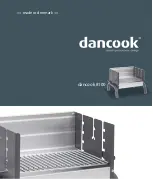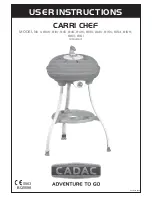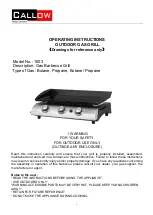
19
meat towards the centre of the rod. Make
sure the fork is fully into the meat. Slide the
other fork onto the rod, into the meat, and
tighten the thumb screw once in place. For
optimal rotisserie cooking, food must be
placed securely onto the middle of the spit
rod and balanced so that the rotisserie can
rotate freely without interference from any
barbecue surfaces. Any loose sections of
meat should be secured so they do not
hang down and interfere with the rotation of
the spit rod. Do not overload the rotisserie.
A chicken or joint of meat of approximately
2kg should be the maximum.
4. Insert the pointed end of the spit rod into
the motor. Lay the other end of the spit rod
onto the opposite bracket.
5. Light the grill as specified in your
barbecue’s instructions.
6. Turn on the rotisserie motor to begin
rotisserie cooking. The hood has been
designed so that it may be closed during
rotisserie cooking.
7. Always cook foods on the lowest flame
setting to avoid burning or overcooking.
8.10. Flare-Up Control
*** Very Important Notice ***
Flare-ups occur when meat is barbecued, and
its fat and juices fall upon the hot flame tamer.
Smoke of course helps give food its barbecued
flavour, but it is best to avoid excessive flare-up
to prevent food being burned. To control flare-
ups, it is
ABSOLUTELY ESSENTIAL
to trim
away excess fat from meat and poultry before
grilling, use cooking sauces and marinades
sparingly and try to avoid very cheap cuts of
meat or meat products as these tend to have a
high fat and water content. Also, the burners
should always be placed on the low setting
during cooking.
When flare-ups do occur, they can usually be
extinguished by applying baking soda or salt
directly onto the flame tamer. Always protect
your hands when handling anything near the
cooking surface of the barbecue and take care
to protect yourself from the flames.
If a fat fire occurs, please see the instructions
given below.
8.11. Fat Fires
Empty and clean the drip tray (and foil liner, if
applicable) of food debris after each cooking
session. If the barbecue is to be used for large
gatherings, it will be necessary to turn off and
cool the barbecue every two hours to remove
food debris from the drip tray (and foil liner, if
applicable) and clean it out. The time between
cleaning may need to be reduced if very fatty
foods or cheap meat products are being
cooked. Failure to do this may result in a fat
fire, which may cause injury and could seriously
damage the barbecue.
In the event of a fat fire:
If safe to do so, turn all control knobs to the
‘off’ position.
Turn off the gas supply at the gas bottle.
Keep everyone at a safe distance from the
barbecue and wait until the fire has burnt
out.
Do not close the hood or lid of the barbecue.
NEVER DOUSE A BARBECUE WITH
WATER. IF AN EXTINGUISHER IS USED,
IT SHOULD BE A POWDER TYPE.
DO NOT REMOVE THE DRIP TRAY.
If the fire does not seem to be abating or
appears to be worsening, contact your local
Fire Brigade for assistance.
8.12. End of Cooking Session
After each cooking session, turn the barbecue
burners to the “high” position and burn for 5
minutes. This procedure will burn off cooking
residue, thus making cleaning easier. Make
sure the hood
or
lid is open during this process.
8.13. Turning Off Your Barbecue
When you have finished using your barbecue,
turn all the control valves fully clockwise to the
“Off” position, then switch off the gas supply at
the bottle.
Wait until the barbecue is sufficiently cool
before closing its hood or lid.
9. Care and Maintenance
Regularly clean your barbecue between uses
and especially after extended periods of
storage. Ensure the barbecue and its
components are sufficiently cool before
cleaning. Do not leave the barbecue exposed to
outside weather conditions or stored in damp,
moist areas.
Never handle hot parts with unprotected
hands.
Never douse the barbecue with water when




































